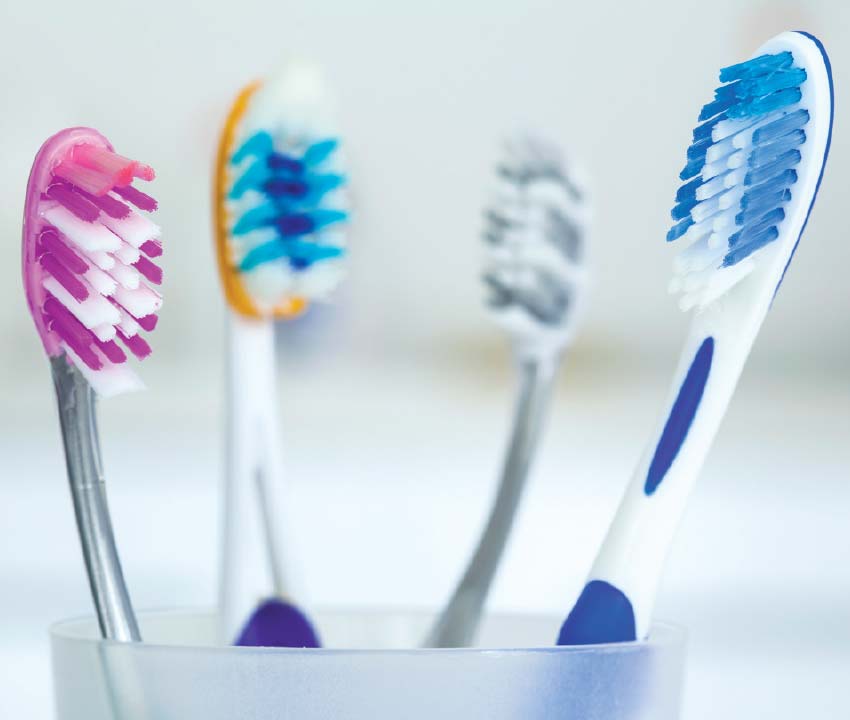Sizing Up Toothbrushes
How to choose the right brush for optimal oral health
Dear Doctor,
With so many toothbrushes on the store shelves, how do I know if I’m choosing the right one?
Dear Mike,
A toothbrush is the primary tool used every day to maintain optimal oral health, so it’s no wonder you want to choose the best one. But when you walk into a local store, you may face a dazzling display of toothbrushes! Selecting the right one may seem like an overwhelming task. The main thing to keep in mind is that a toothbrush has three basic functions: (1) to remove dental plaque (an invisible film of bacteria) and food debris from teeth; (2) to minimize tartar build-up; and (3) to stimulate gum tissue and prevent or reduce inflammation (gingivitis).
 |
Bristle Firmness
Most dentists and hygienists recommend a “soft” toothbrush, so this should be your starting point. Although it may seem that hard bristles would result in better cleaning, they can create other problems, such as gum recession. This condition exposes the root surfaces of teeth to abrasion and erosion, resulting in gumline sensitivity to touch, heat and/or cold, and acidic foods. A soft brush, in contrast, can remove plaque without harming the teeth or irritating the gums.
Even medium-hard bristles can cause twice as much tissue damage as soft bristles, according to a 2013 study. Narrowing your selection to the soft ones still allows plenty of choices—and lets you consider several other factors.
Bristle Rounding and Length
Toothbrush bristles have different degrees of end-rounding to smooth out the rough jags that may result during manufacturing. Rounded bristles are best for the gums. According to a 2016 study, non-rounded bristles caused gum recession to increase by 30%. Bristle length can also influence the effectiveness of a toothbrush. Bristles on many toothbrushes are multi-leveled or angled for cleaning between teeth and at the gum line, and most toothbrushes have longer bristles on one end to clean the back teeth more effectively.
Toothbrush Size and Shape
It’s important to pick a toothbrush that fits your mouth. Some people find an angled neck and tapered head helpful. If the bristles are too long, it will be difficult to reach around the back teeth; if too short, you may have to work harder to clean all tooth surfaces. Handles with larger grips can be useful for those who lack manual dexterity, such as young children and people with arthritis. In short, choose a toothbrush that feels comfortable and is easy to use.
ADA Seal of Acceptance
The American Dental Association (ADA) puts a Seal of Acceptance on toothbrushes that have been submitted for evaluation and meet certain standards. Toothbrushes with the ADA seal have been shown to be safe and effective if properly used. However, some smaller companies produce high-quality toothbrushes without seeking the ADA seal. When in doubt, ask your dentist or hygienist to recommend a toothbrush that’s right for you.
Manual vs. Electric Toothbrush
According to the ADA, electric and manual brushes work equally well. An electric toothbrush is recommended for those who have limited manual dexterity, cannot brush effectively with a manual toothbrush or do not brush long enough. You should use the same criteria to evaluate the toothbrush regardless of whether it is electric or manual. No matter what kind of brush you choose, the important thing is to brush twice a day, using no more than a pea-sized amount of fluoride toothpaste for anyone over age 3—and a smear the size of a rice grain for infants.
It’s Not the Brush, It’s the Hand That Holds It
When it comes to oral health, the brush is only as good as the hand that moves it. Good brushing technique—along with a consistent brushing and flossing habit—is essential to maintaining good oral hygiene.
Brushing doesn’t require much elbow grease. If your gums bleed, your toothbrush may be too hard, you may be brushing too hard, or you may have gum disease. Even a soft toothbrush can cause damage if you brush with too much force or too frequently. Gentle brushing with a soft brush adequately removes debris and breaks up plaque. There is no one best way to brush. However, you should not scrub your teeth vigorously even with a soft brush. It’s better to jiggle the brush in a tight circular or oval motion angled slightly towards the gum, and to brush for at least two minutes. As long as your method removes plaque and doesn’t cause harm, it is acceptable. You can check on the effectiveness of plaque removal by chewing on an over-the-counter disclosing tablet that reveals any remaining plaque.
Toothbrushes do not last forever. When the bristles become misshapen, frayed and splayed, it’s time for a replacement—usually in 3 to 4 months.
In summary, a good toothbrush is one that effectively removes plaque and food debris while not damaging the gums or teeth. For most people, the safest choice is a soft toothbrush with rounded bristle tips. But if you have a hard toothbrush, don’t rush to throw it out—you can always use it to scrub your bathroom grout. Just be sure not to put it in your mouth.



